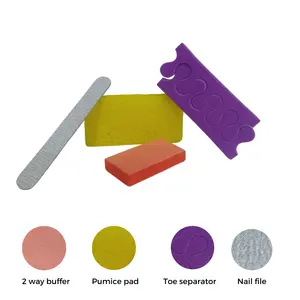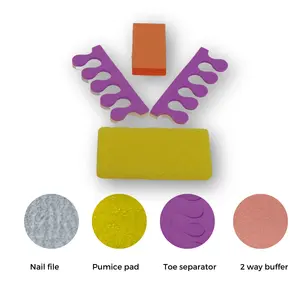
All categories
Featured selections
Trade Assurance
Buyer Central
Help Center
Get the app
Become a supplier

(1188 products available)







































Keeping nails clean and well-groomed is an important part of personal hygiene and self-care. Manicures and pedicures at home can be as simple as trimming, shaping, and moisturizing the nails and cuticles. They can also be more complex by adding coats of nail polish or specialized treatments. There are different types of manicure and pedicure treatments that can be done at home, including:
There are many factors to consider when choosing products for at-home manicures and pedicures. Here are some tips:
Skin and Nail Type:
The first step is to understand the user's skin and nail type. Does the skin get dry easily? Do the nails bend or break often? The type will be known based on how the skin and nails look. When the type is understood, products can be chosen that will work best. For example, if the skin gets dry, a moisturizing nail polish remover is needed. If the nails bend, a strengthening base coat is needed.
Desired Look:
The next step is to think about how the manicure or pedicure should look when finished. Do pretty colors want to be painted on the nails, or just a clear coat? Do nail designs want to be drawn, or does the user want to keep the nails natural? Figuring out the desired look will help decide which polishes and tools to purchase. Nail designs will need thin brushes, while just adding color will require a simple polish.
Time:
The amount of time available to spend on the manicure or pedicure needs to be thought about. If a lot of time is available, more coats of polish and designs can be done. If less time is available, only one coat of polish may be needed. Knowing how much time is available will help choose products that take a longer or shorter application.
Budget:
The budget for buying new nail products needs to be considered. A lot of money does not want to be spent if only a few items are needed. Buying sets of products that have everything needed is a good way to save money. Or, buying basic items and adding to them later is another option.
Sustainable:
Does the user want to choose nail products that are good for the environment? If so, look for polishes made from natural ingredients. Also, search for removers that are non-toxic and vegan. Many brands are now offering sustainable options to choose from.
Product Reviews:
It is also helpful to read reviews from other people before buying. See what others said about how well the product works and if they had any problems. Reviews can show if a purchase is a good deal or if money should be spent elsewhere.
Here's a simple step-by-step process for a manicure and pedicure.
Prepare the nails
It's important to remove any nail polish before starting the manicure or pedicure. This will clean the nail and make it ready for new polish. Use a cotton ball and nail polish remover to take off the old polish. If the polish is hard to remove, try soaking the cotton ball with the remover and leaving it on the nail for a few seconds before wiping it off. Wash hands and feet with soap and water to remove any leftover polish or chemicals. Dry them well with a towel.
Shape the nails
Use a nail clipper to cut the nails to a desired length. Be careful not to cut them too short, as this can be painful. After trimming, use a nail file to smooth the edges. File in one direction rather than back and forth to prevent the nail from splitting. Choose a nail shape that goes with the fingers or toes, like square, oval, or almond. Be careful not to file the nails too thin, which can make them weak.
Softening the skin and cuticles
Soak the fingers and toes in warm, soapy water for 5-10 minutes to soften the skin and cuticles. Use a small bowl for the hands and a larger one for the feet. Add mild soap and warm water. If there are any rough skin patches or calluses, use a pumice stone or foot file to gently remove dead skin. Be careful not to file the skin too much, as this can cause soreness.
Moisturizing
Apply cuticle oil or cream to each nail and massage it for a few minutes. This will help soften the cuticles and make them easier to push back. Use a wooden stick or metal tool to gently push back the cuticles. Be careful not to push them too far back, as this can cause discomfort. Trim any excess skin with a nail clipper.
Apply nail polish
Shake the nail polish bottle to mix it up. Start with a clear base coat to protect the nail from stains and help the colored polish stick better. After the base coat dries, choose a color and carefully paint it on. Start in the center of the nail and then add more along the sides. Let the first coat dry completely before adding a second coat. Once the second coat dries, finish with a clear top coat to add shine and make the color last longer. When painting toenails, it's best to use a separate bottle of polish so the same brush doesn't spread bacteria from the feet to the hands.
Cleaning and Exfoliating
Cleaning and exfoliating is one of the primary functions of a manicure and pedicure. The nails are cleaned and shaped, and the skin is exfoliated to remove dead skin cells and calluses.
Nail Care
The nails are then cared for by being shaped, buffed, and shined. They may also be painted with polish to add color and shine.
Moisturizing and Massaging
The hands and feet are then moisturized with lotion or oil, and a massage is often included to help relax the muscles and improve circulation.
Easy-to-Use Tools and Products
Many manicures and pedicures at home kits contain high-quality, easy-to-use tools and products that can help achieve professional-looking results. These tools and products are designed for use at home and are perfect for anyone who wants to save time and money by doing their nails themselves.
Portable Kits
Portable manicure and pedicure kits are compact and easy to travel with, making them ideal for on-the-go nail care. These kits usually contain all the essential tools and products needed for a manicure or pedicure, such as nail clippers, files, cuticle pushers, and polishes.
LED Light for Gel Nails
Some home manicure and pedicure sets include an LED light specifically designed for curing gel nails. This feature allows users to apply gel polish at home without visiting a professional salon.
Compact and Travel-Friendly
Many at-home manicure and pedicure sets are compact and travel-friendly, making them easy to take anywhere. This is especially helpful for people who like to do their nails on the go or need to bring their nail supplies with them when they travel.
Stylish and Modern
Many at-home manicure and pedicure sets are stylish and modern, featuring sleek designs and contemporary finishes. This makes them not only functional but also a great addition to any beauty collection.
Durable and High-Quality Materials
Many at-home manicure and pedicure sets are made from durable, high-quality materials designed to last. This is important for people who use their nail tools frequently and want them to hold up over time.
Q1: How often should one do a manicure or pedicure?
A1: A manicure or pedicure should be done at least every 3 weeks. This is the time it takes for nails to grow out. However, this can change based on how fast some people's nails grow, if they have hangnails, or if their skin is getting dried out and needs more hydration.
Q2: What is the difference between a manicure and a pedicure?
A2: A manicure is a beauty treatment for the hands and fingernails, while a pedicure is a similar treatment for the feet and toenails. Both procedures involve cleaning, shaping, and polishing the nails, but they also include specific care for the hands and feet.
Q3: What are the benefits of a manicure and pedicure?
A3: The benefits of a manicure and pedicure include improved appearance and increased self-confidence, relaxation and stress relief, and promotion of better overall hand and foot health.
Q4: Can a manicure and pedicure last longer?
A4: Yes, manicures and pedicures can last longer when nails are not exposed to harsh chemicals, when gloves are worn while cleaning, and when a small touch-up is done every other day.